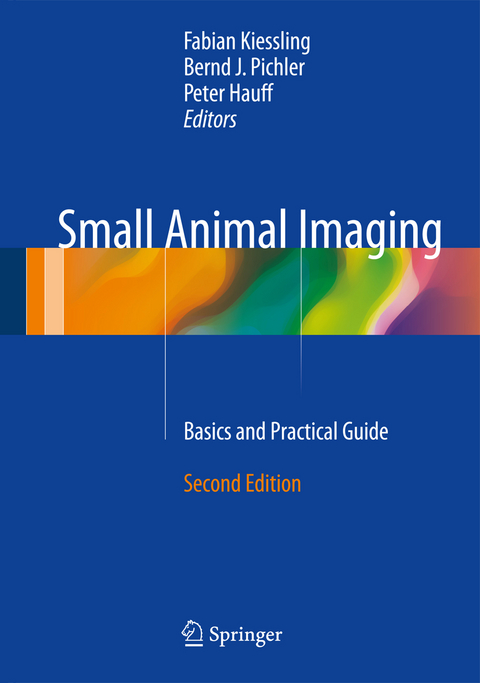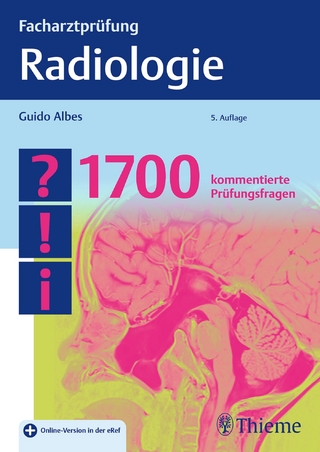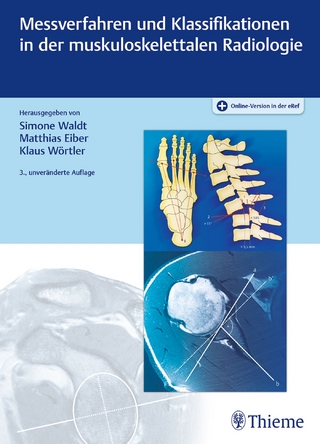
Small Animal Imaging
Springer International Publishing (Verlag)
978-3-319-42200-8 (ISBN)
Since 2008 Professor Dr. Fabian Kiessling is leading the Institute for Experimental Molecular Imaging at the Helmholtz Center of Applied Engineering of the RWTH-University in Aachen. Aim of his research is the development of novel diagnostic probes and imaging tools for a disease specific diagnosis and therapy monitoring. In this context, the main focus is on the investigation of angiogenesis related processes. Fabian Kiessling studied Medicine and graduated at the University of Heidelberg. Until the end of 2002, he worked as resident in the Department of Radiology at the German Cancer Research Center (DKFZ) in Heidelberg. In 2003 he changed to the Department of Medical Physics in Radiology of the DKFZ as leader of the Molecular Imaging group. In parallel he did his clinical training at different Departments of the University of Heidelberg and received the board certification as clinical Radiologist in 2007. Fabian Kiessling habilitated in experimental radiology in 2006. He is author of more than 240 publications and book chapters, received several research awards, among those the „Emil Salzer Price for Cancer Research” and the “Richtzenhain Price”. Shortly after his change to the RWTH-Aachen University he founded the invivoContrast GmbH together with Professor Matthias Bräutigam, which is distributing diagnostic probes for the preclinical market.
Part I Role of small animal imaging: Non invasive imaging for supporting basic research.- Non invasive imaging in the pharmaceutical industry.- How to set up a small animal imaging unit.- Significance of non invasive imaging for animal protection.- Animal Models: From zebrafish to non human primates.
Part II Study planning and animal preparation: Institutional preconditions for small animal imaging.- Statistical considerations for animal imaging studies.- Animal anesthesia and monitoring.- Drug administration.
Part III Imaging modalities and probes: How to choose the right imaging modality.- How to identify suitable Biomarkers.- Concepts in diagnostic probe design.- X-ray and X-ray-CT.- CT contrast agents.- MR contrast agents.- MRS.- Hyperpolarized MRI.- Ultrasound.- Ultrasound contrast agents.- PET and SPECT.- Radiotracer I: Standard tracer.- Radiotracer II: Peptide-based radiopharmaceuticals.- Optical imaging.- Photoacoustic imaging.- Optical probes.- Multimodal imaging and image fusion.
Part IV Ex vivo validation methods:Methods for correlation between in vivo small ani-mal images and post mortem data: example brain.- In Vitro Methods for In Vivo Quantitation of PET and SPECT Imaging Probes: Autoradiography and Gamma Counting.
Part V: Data postprocessing: Qualitative and quantitative data analysis.- Guidelines for nuclear image analysis.- Kinetic modeling.- Data documentation systems.
Part VI: Special applications:Imaging in drug safety Evaluation.- Cell tracking and transplant imaging.- Imaging of metabolic diseases.- Imaging in developmental biology.- Imaging in gynecology research.- Imaging in cardiovascular research.- Imaging in neurology research I: Neuoroncology.- Imaging in neurology research II: Plasticity and cognitive networks.- Imaging in neurology research III: Neurodegenerative diseases.- Neurooptogenetics.- Imaging in oncology research.- Imaging in immunology research.- Imaging of infectious diseases.
"This book gives a detailed overview of the current situation regarding imaging of small animals with lots of tips and considerations and I can wholeheartedly recommend it." (Maurits Jansen, RAD Magazine , May, 2018)
"This is the second edition of a book that addresses the use of imaging techniques in research involving small animals as test subjects. ... appropriate for individuals with a pre-existing solid foundation in imaging who are engaged in, or plan a career focusing on, research applications of imaging techniques. ... It is comprehensive and highly detailed, and individual researchers will likely find a select number of chapters pertinent to their work ... ." (Marcella D. Ridgway, Doody'sBook Reviews, August, 2017)
| Erscheinungsdatum | 05.01.2017 |
|---|---|
| Zusatzinfo | XIX, 875 p. 396 illus., 284 illus. in color. |
| Verlagsort | Cham |
| Sprache | englisch |
| Maße | 178 x 254 mm |
| Themenwelt | Medizin / Pharmazie ► Medizinische Fachgebiete ► Laboratoriumsmedizin |
| Medizin / Pharmazie ► Medizinische Fachgebiete ► Pharmakologie / Pharmakotherapie | |
| Medizinische Fachgebiete ► Radiologie / Bildgebende Verfahren ► Radiologie | |
| Schlagworte | Animal anesthesia • Cost-effective imaging • Diagnostic probe design • Established imaging modalities • Identifying Biomarkers • Imaging / Radiology • laboratory medicine • Medicine • MR contrast agents • Non invasive Imaging in Animals • Pharmacology/Toxicology • Preclinical Research |
| ISBN-10 | 3-319-42200-6 / 3319422006 |
| ISBN-13 | 978-3-319-42200-8 / 9783319422008 |
| Zustand | Neuware |
| Haben Sie eine Frage zum Produkt? |
aus dem Bereich


